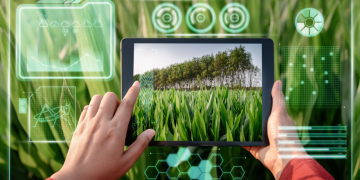As the world grapples with the accelerating impacts of climate change, new solutions and innovations are urgently needed to address the growing environmental challenges. In recent years, artificial intelligence (AI) has emerged as a powerful tool with the potential to revolutionize efforts to mitigate climate change. From reducing greenhouse gas emissions to optimizing energy use, AI technologies could be pivotal in helping nations and industries move toward more sustainable practices. However, the potential for AI to positively impact the environment raises important questions about its role in combating climate change and the ethical, economic, and technological challenges that come with it.
In this article, we will explore how AI can be leveraged to combat climate change, drawing on insights from environmentalists, technologists, and industry leaders. We will discuss the potential applications of AI in environmental monitoring, energy optimization, sustainable agriculture, and more. We will also address the challenges and considerations that must be taken into account to ensure that AI contributes to a greener and more sustainable future.
The Environmental Impact of AI: A Double-Edged Sword
Before diving into the positive impacts that AI can have on the environment, it is important to first acknowledge the potential environmental costs of AI technologies. While AI holds great promise for climate change mitigation, it also requires substantial computational power, energy, and resources to operate.
AI’s Energy Consumption
AI systems, particularly those involved in deep learning and machine learning, require significant computational resources to train and deploy. Data centers that house AI algorithms consume vast amounts of energy to power their operations and cool the hardware. The energy consumption of AI technologies has raised concerns about their environmental footprint, particularly as the use of AI expands globally.
For example, research has shown that training large-scale AI models can produce carbon emissions comparable to those of an entire country. This raises important questions about the sustainability of AI technologies and whether the environmental costs outweigh the benefits. As AI continues to evolve, it will be crucial to find ways to minimize its carbon footprint through more energy-efficient hardware, improved algorithms, and the use of renewable energy sources.
Balancing the Scale: Environmental Benefits vs. AI’s Footprint
While AI itself has an environmental cost, its potential to drive positive change in climate-related fields offers a compelling argument for its responsible use. The key will be to balance the environmental cost of AI with its benefits in combating climate change. As AI technologies continue to improve, the hope is that their energy efficiency will also increase, allowing them to provide significant environmental benefits without exacerbating the climate crisis.

AI in Environmental Monitoring and Data Collection
One of the most promising applications of AI in the fight against climate change lies in its ability to analyze and interpret large datasets related to environmental conditions. By harnessing AI to monitor and analyze environmental data, researchers and policymakers can make more informed decisions about how to combat climate change and protect natural resources.
Climate Modeling and Prediction
AI has the potential to significantly improve climate modeling and predictions. Traditional climate models, while effective, often struggle to account for the complex interactions between various environmental systems. AI algorithms, however, can analyze vast amounts of data to uncover hidden patterns and make more accurate predictions about climate trends, extreme weather events, and the long-term impacts of global warming.
Machine learning models, for example, can be trained to predict the frequency and intensity of hurricanes, droughts, floods, and other natural disasters. These predictions can inform disaster preparedness efforts, allowing governments and communities to take proactive measures to reduce the impact of climate events.
Satellite Imaging and Remote Sensing
AI technologies are also being used in combination with satellite imaging and remote sensing to monitor the health of ecosystems, track deforestation, and assess the impacts of climate change on biodiversity. AI-powered image recognition and analysis tools can automatically detect changes in land use, forest cover, and ocean health, providing real-time insights into environmental conditions.
These AI-driven monitoring systems can also help identify areas of critical concern, such as rising sea levels or the melting of polar ice caps, allowing for more targeted interventions to mitigate the effects of climate change.
AI in Energy Optimization and Efficiency
Energy production and consumption are central to the issue of climate change. Fossil fuel-based energy systems are the primary contributors to greenhouse gas emissions, which drive global warming. As such, transitioning to renewable energy sources and optimizing energy usage is crucial for reducing carbon emissions and mitigating climate change.
AI in Renewable Energy Integration
AI is already playing a key role in optimizing the integration of renewable energy sources, such as wind and solar power, into the grid. One of the challenges with renewable energy is its intermittency—wind and solar power generation can vary depending on weather conditions. AI algorithms can predict energy production from renewable sources based on weather patterns and historical data, helping grid operators balance supply and demand more efficiently.
For example, AI can forecast solar power production based on cloud cover, temperature, and time of day, allowing energy providers to adjust their systems in real-time to maximize efficiency. This can reduce reliance on fossil fuel-powered backup generators and help ensure that renewable energy sources are fully utilized.
Smart Grids and Energy Management
AI is also playing a crucial role in the development of smart grids, which use advanced data analytics and machine learning to optimize the distribution of electricity. Smart grids can automatically adjust energy distribution based on real-time demand and consumption patterns, reducing waste and improving efficiency. AI-powered systems can also be used to detect and diagnose issues within the grid, preventing outages and ensuring that energy is delivered in the most efficient manner possible.
Additionally, AI can help consumers reduce their energy consumption by providing personalized recommendations on how to use energy more efficiently. For example, AI-driven energy management systems can adjust heating and cooling in buildings, optimize the use of appliances, and even suggest changes to behavior that reduce energy use.
AI in Sustainable Agriculture
Agriculture is another key sector that is impacted by climate change and also contributes to environmental degradation through practices such as deforestation, overuse of water, and excessive fertilizer use. AI has the potential to transform agriculture by optimizing resource use, reducing waste, and increasing the resilience of crops to climate-related stresses.
Precision Agriculture
AI-powered precision agriculture is already helping farmers use resources more efficiently. By using AI algorithms to analyze data from sensors, drones, and satellite imagery, farmers can make more informed decisions about irrigation, fertilization, and pest control. This can reduce the overuse of water, chemicals, and other resources, leading to more sustainable farming practices.
For example, AI can analyze soil health and moisture levels to determine the optimal amount of water and fertilizer needed for crops, reducing water waste and minimizing the environmental impact of farming. AI can also predict crop yields, helping farmers plan for future harvests and reduce food waste.
Climate-Resilient Crops
AI is also being used to develop climate-resilient crops that are better suited to changing environmental conditions. Machine learning algorithms can analyze genetic data to identify traits that make crops more resistant to drought, heat, and pests. This could help farmers adapt to changing climate conditions and ensure food security in the face of climate change.
Ethical Considerations and Challenges
While the potential for AI to address climate change is vast, there are several ethical and practical challenges that need to be considered.
Ensuring Access and Equity
One of the key concerns with AI in the fight against climate change is ensuring that its benefits are accessible to all. Developing countries and marginalized communities may lack the resources to implement AI technologies, even though they are often the most vulnerable to the effects of climate change. Ensuring that AI solutions are equitable and inclusive will be critical in ensuring that AI helps, rather than exacerbates, global inequality.
Data Privacy and Security
AI-driven climate solutions often rely on large datasets, which can include sensitive information such as weather patterns, crop yields, and energy consumption. Ensuring the privacy and security of this data is essential to prevent misuse and protect individuals and communities from potential harm.
Conclusion: Harnessing the Power of AI for a Sustainable Future
AI has the potential to play a transformative role in the fight against climate change, offering solutions that can optimize energy use, reduce emissions, improve agricultural practices, and provide real-time insights into environmental conditions. However, to ensure that AI contributes to a sustainable future, it is essential that its development is guided by ethical considerations, equitable access, and a commitment to minimizing its environmental footprint.
As governments, businesses, and researchers continue to explore the potential of AI in climate change mitigation, it is clear that this technology holds the promise of a more sustainable, efficient, and resilient future. By harnessing the power of AI in ways that align with environmental goals, we can move closer to a world where both technological advancement and climate sustainability go hand in hand.











































